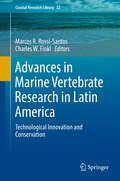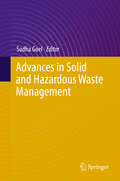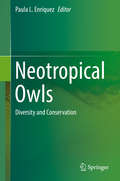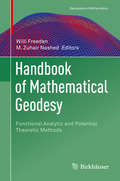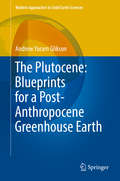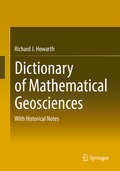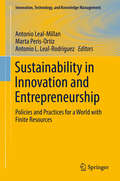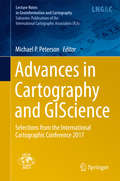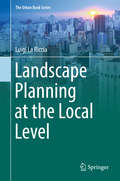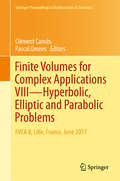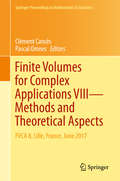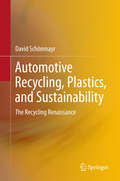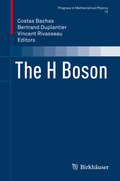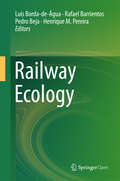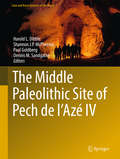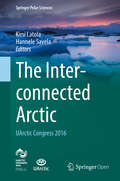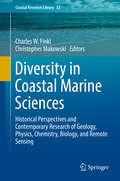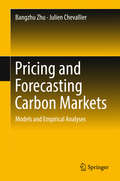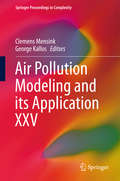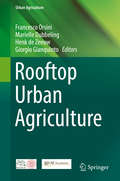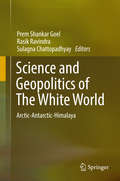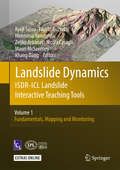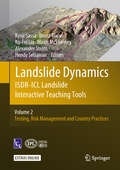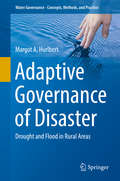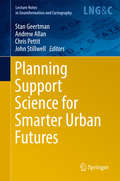- Table View
- List View
Advances in Marine Vertebrate Research in Latin America: Technological Innovation and Conservation (Coastal Research Library #22)
by Marcos R. Rossi-Santos Charles W. FinklThis book gathers the most recent research findings on ecology and conservation of marine vertebrates in Latin America, making use of high technological methods to show readers the diversity of the marine research that has been conducted in these countries over the last decades. The book brings authors from more than 23 institutions of 7 different countries developing the most diverse research aiming at ocean conservation through the ecology of different vertebrate animals, such as whales, dolphins, manatees, turtles, seabirds and fish.This book deals with technological advances and innovation in the ecology and conservation of marine vertebrates in Latin America. This eclectic collection is broad in scope but provides detailed summaries of new methods that are deployed in the study of marine environmental conservation. Key issues revolve around the development and application of educational methodologies in the field of marine vertebrate research, which provide a rational basis for better management of marine environments using modern techniques associated with GIS, satellite tracking, aerial systems, bioacoustics, biogeochemistry, genetics, underwater videography, species photoidentification, molecular biology, trophic ecological methods, ethological methods, and behavioural ecology, among others. Discussion and elucidation of these kinds of techniques are aimed at university-level students and post-graduate researchers. The scope of this volume includes whales, sharks, rays, dolphins, tropical fishes, turtles, manatees as well as aspects of Latin American marine ecosystem conservation. Researchers in this biogeographic region, as well as others involved with marine vertebrate research, will find this work essential reading.
Advances in Solid and Hazardous Waste Management
by Sudha GoelThis book presents reviews, examples and case studies of innovative applications in solid and hazardous waste management. The economics of waste management have since become a significant research area in their own right, and two chapters address these issues. In addition, dedicated chapters cover specific categories of waste such as biomedical and institutional waste, plastics and e-waste. The book subsequently discusses newer analytical methods like SEM, EDX, XRD and optical microscopy, along with selected “older” methods for sampling and characterizing different types of waste. The various applications of mathematical tools like linear optimization, various software/models like WISCLeach, and DRASTIC, and tools like remote sensing and GIS are illustrated in many of the chapters. Lastly, since composting is one of the most popular treatment methods for managing the organic component of municipal solid waste, the book provides an overview of composting and the fundamentals of microbiology that are essential to understanding waste-related biological processes. The book was primarily written for students and practitioners in the field who are already familiar with the basics. All chapters were prepared by practicing experts and scholars in the field, and are intended to help readers better understand and apply these principles and practices in their own endeavours. Key topics covered in the book: • The circular economy and the economics of solid waste management • Various remote sensing and GIS applications for managing municipal solid waste, coal fires in mines, changes in land use and land cover in industrial areas, etc. • Treatment and management of different types of solid waste: institutional (including biomedical), residential, e-waste, plastic, and ash from thermal power plants • Sampling and characterization of municipal waste and compost • Fundamentals of microbiology • Overview of environmental regulations, especially those pertaining to solid and hazardous waste management
Neotropical Owls: Diversity and Conservation
by Paula L. EnriquezThis book presents a comprehensive biological and ecological information about owls in the neotropic area. In addition the book covers topics such as threats and conservation strategies for these nocturnal birds of prey from 18 Neotropical countries. Owls are a good example of diversification processes and have developed evolutionary characteristics themselves. These species are found almost everywhere in the world but most of them are distributed in tropical areas and about a third of them live in the Neotropics. This biogeographic region has a high biodiversity and even share lineages of species from other continents because at some point all were part of Pangea. Although we still have much to know and understand about this diverse, scarcely studied and threatened group this work aims to be a precedent for future and further research on the subject.
Handbook of Mathematical Geodesy: Functional Analytic and Potential Theoretic Methods (Geosystems Mathematics)
by Willi Freeden M. Zuhair NashedWritten by leading experts, this book provides a clear and comprehensive survey of the “status quo” of the interrelating process and cross-fertilization of structures and methods in mathematical geodesy. Starting with a foundation of functional analysis, potential theory, constructive approximation, special function theory, and inverse problems, readers are subsequently introduced to today’s least squares approximation, spherical harmonics reflected spline and wavelet concepts, boundary value problems, Runge-Walsh framework, geodetic observables, geoidal modeling, ill-posed problems and regularizations, inverse gravimetry, and satellite gravity gradiometry. All chapters are self-contained and can be studied individually, making the book an ideal resource for both graduate students and active researchers who want to acquaint themselves with the mathematical aspects of modern geodesy.
The Plutocene: Blueprints for a Post-Anthropocene Greenhouse Earth (Modern Approaches in Solid Earth Sciences #13)
by Andrew Yoram GliksonThis book presents projections and blueprints of the future geologic period, climate and biosphere, based on our current understanding of the Earth’s history and recent developments in the atmosphere-ocean-cryosphere system. By the second decade of the 21st century it has become clear that, rather than channel its efforts into protecting its planetary biosphere and living species, Homo sapiens continues to sink its remaining resources into weapons, including nuclear missiles – thus increasing the risk of intentional or accidental spread of radioactive nuclides on land, oceans and atmosphere. With time, possibility becomes probability, and probability becomes certainty ‒ heralding a transition from the Anthropocene to a new geological period, named here as Plutocene after the element Plutonium. During the Plutocene the biosphere is dominated by elevated temperatures, analogous to the Pliocene (2.6 – 5.3 Ma ago) or the Miocene (5.3 - 23 Ma ago) when mean global temperatures were 2 to 4 degrees Celsius warmer and sea levels 20 to 40 meters higher than pre-industrial levels. High levels of radioactivity will persist for at least 20,000 years and acid oceans will severely limit biological activity to the hardiest species. Atmospheric CO2 higher than 500 ppm with residence time on the order of thousands of years will delay the subsequent glacial cycle. These factors restrict comparisons of the Plutocene with biosphere conditions during the Miocene and Pliocene periods, partly because the flora and fauna evolved more gradually during these periods, unlike the abrupt climate shift of state during the second half of the 20th century and first part of the 21st century. Following a long lull in biological activity dominated by radiation-resistant organisms, especially Arthropods, a resumption of glacial cycles and decline in radioactivity will lead to the re-emergence of descendants of burrowing mammals and other genera. Depending on the intensity of radioactive pollution, hunter-gatherer humans may survive in northern latitudes, relatively cold high-altitude mountain valleys and elevated volcanic islands. In some areas subsistence farming may be possible. A new cycle will commence.
Dictionary of Mathematical Geosciences: With Historical Notes
by Richard J. HowarthThis dictionary includes a number of mathematical, statistical and computing terms and their definitions to assist geoscientists and provide guidance on the methods and terminology encountered in the literature. Each technical term used in the explanations can be found in the dictionary which also includes explanations of basics, such as trigonometric functions and logarithms. There are also citations from the relevant literature to show the term’s first use in mathematics, statistics, etc. and its subsequent usage in geosciences.
Sustainability in Innovation and Entrepreneurship: Policies and Practices for a World with Finite Resources (Innovation, Technology, and Knowledge Management)
by Antonio Leal-Millan Marta Peris-Ortiz Antonio L. Leal-RodríguezThis book provides a richly illustrated study of sustainability, innovation and entrepreneurship. Specifically, it examines the ways in which governmental policies and practices modify the social conditions necessary to promote innovation in businesses and by so doing impact economic development. Exploring topics such as green innovation, green customer capital, smart cities, green entrepreneurship and environmental responsibility, this book presents some of the most current research and best practices in the field.In today’s global economy, strategies, policies and practices that address the negative effects of human activity on the environment need to be incorporated into the business framework in order for companies to achieve a sustainable competitive advantage. Around the world, such changes have already resulted in a broad range of products, production methods and technical features that ensure environmental protection. At the same time, the mass media’s communication of a deteriorating earth have motivated a growing number of citizens in both developed and developing nations to modify their consumption habits towards more ecological products. Consequently, an increasing number of companies are reacting to these changes in business and legal frameworks and consumer preferences by investing in new forms of green innovation or “eco-innovation” designed to promote both environmental and corporate sustainability. For example, Hewlett-Packard eliminated lead from its welding process; Wal-Mart reduced the emissions of their suppliers; and Cisco, Dell and IBM are investing in smart grids. This volume showcases pioneering efforts among companies, citizens, and government agencies that are moving from theory to practice by placing sustainability at the core of their development strategies.
Advances in Cartography and GIScience: Selections from the International Cartographic Conference 2017 (Lecture Notes in Geoinformation and Cartography)
by Michael P. PetersonThis book presents a selection of manuscripts submitted to the 2017 International Cartographic Conference held in Washington, DC at the beginning of July and made available at the conference. These manuscripts have been selected by the Scientific Program Committee and represent the wide-range of research that is done in the discipline. It also forms an important international collection representing research from at least 30-40 countries.
Landscape Planning at the Local Level (The Urban Book Series)
by Luigi La RicciaThe book, showing virtuous examples of urban planning in Italy and Europe, exposes certain doubts and open questions: what is the new role of urban planning? What actions / rules are now achievable for the protection, planning and management of local-scale landscapes? The overall reflections gathered in the book contribute to suggest innovative visions about landscape planning at local scale, seen as first steps towards a more functional change of perspective. New landscapes are the result of local planning practices that no longer seem able to “understand” the current society through urban design. Public space and new urban centralities interact with the increasingly complex functions of social life and mark the distance from territorial values, relying less and less on physical relationships (economic and functional) and increasingly on symbolic and intangible relationships, as ‘cultural identity’. Landscape is essential for the sustainable future of the urban and rural territory: the landscape quality is a factor of economic competitiveness and acts also as a factor of social cohesion and integration.
Finite Volumes for Complex Applications VIII - Hyperbolic, Elliptic and Parabolic Problems: FVCA 8, Lille, France, June 2017 (Springer Proceedings in Mathematics & Statistics #200)
by Clément Cancès Pascal OmnesThis book is the second volume of proceedings of the 8th conference on "Finite Volumes for Complex Applications" (Lille, June 2017). It includes reviewed contributions reporting successful applications in the fields of fluid dynamics, computational geosciences, structural analysis, nuclear physics, semiconductor theory and other topics.The finite volume method in its various forms is a space discretization technique for partial differential equations based on the fundamental physical principle of conservation, and recent decades have brought significant advances in the theoretical understanding of the method. Many finite volume methods preserve further qualitative or asymptotic properties, including maximum principles, dissipativity, monotone decay of free energy, and asymptotic stability. Due to these properties, finite volume methods belong to the wider class of compatible discretization methods, which preserve qualitative properties of continuous problems at the discrete level. This structural approach to the discretization of partial differential equations becomes particularly important for multiphysics and multiscale applications.The book is useful for researchers, PhD and master’s level students in numerical analysis, scientific computing and related fields such as partial differential equations, as well as for engineers working in numerical modeling and simulations.
Finite Volumes for Complex Applications VIII - Methods and Theoretical Aspects: FVCA 8, Lille, France, June 2017 (Springer Proceedings in Mathematics & Statistics #199)
by Clément Cancès Pascal OmnesThis first volume of the proceedings of the 8th conference on "Finite Volumes for Complex Applications" (Lille, June 2017) covers various topics including convergence and stability analysis, as well as investigations of these methods from the point of view of compatibility with physical principles. It collects together the focused invited papers comparing advanced numerical methods for Stokes and Navier–Stokes equations on a benchmark, as well as reviewed contributions from internationally leading researchers in the field of analysis of finite volume and related methods, offering a comprehensive overview of the state of the art in the field.The finite volume method in its various forms is a space discretization technique for partial differential equations based on the fundamental physical principle of conservation, and recent decades have brought significant advances in the theoretical understanding of the method. Many finite volume methods preserve further qualitative or asymptotic properties, including maximum principles, dissipativity, monotone decay of free energy, and asymptotic stability. Due to these properties, finite volume methods belong to the wider class of compatible discretization methods, which preserve qualitative properties of continuous problems at the discrete level. This structural approach to the discretization of partial differential equations becomes particularly important for multiphysics and multiscale applications.The book is a valuable resource for researchers, PhD and master’s level students in numerical analysis, scientific computing and related fields such as partial differential equations, as well as engineers working in numerical modeling and simulations.
Automotive Recycling, Plastics, and Sustainability: The Recycling Renaissance
by David SchönmayrThis book provides transdisciplinary analyses of the automotive plastics production and recycling system, including prognoses, scenarios and solutions for corporate sustainability management.A book on plastics, not written by a plastics guy. But a sustainability guy. Plastics schizophrenia and the automotive abyss: The industry is facing a severe challenge. It is the inevitable and promising change towards a sustainable economy. However, the automotive industry is primarily concerned with the CO2 emissions from cars when driving, while the rise of lightweight plastics, electric drive and heavy batteries make the production and end-of-life phase ever more important. Therefore, the currently increasing use of non-sustainable virgin plastics in cars has to be tackled.The plastics and the automotive industry now have a chance, and this chance is the Recycling Renaissance.This book offers:• Holistic and transdisciplinary overview on sustainability and automotive plastics from all angles including economy, ecology, technology, and politics with a focus on Europe• Concise analyses, prognoses, tools and a roadmap with solutions for companies, developed together with international experts from industry and academia • Strong scientific basis and independent research including a Europe-wide survey, expert interviews, and workshops• More than 80 illustrations and 15 tables including a SCOT analysis • Executive summaries after each chapter for fast reading“The uniqueness of this book lies within the different point of view on this topic from a critical, outstanding scientist.” - Univ.-Prof. Dipl.-Ing. Dr.mont. Pomberger, Montanuni Leoben
The H Boson (Progress in Mathematical Physics #72)
by Costas Bachas Bertrand Duplantier Vincent RivasseauThis volume provides a detailed description of the seminal theoretical construction in 1964, independently by Robert Brout and Francois Englert, and by Peter W. Higgs, of a mechanism for short-range fundamental interactions, now called the Brout-Englert-Higgs (BEH) mechanism. It accounts for the non-zero mass of elementary particles and predicts the existence of a new particle - an elementary massive scalar boson. In addition to this the book describes the experimental discovery of this fundamental missing element in the Standard Model of particle physics. The H Boson, also called the Higgs Boson, was produced and detected in the Large Hadron Collider (LHC) of CERN near Geneva by two large experimental collaborations, ATLAS and CMS, which announced its discovery on the 4th of July 2012.This new volume of the Poincaré Seminar Series, The H Boson, corresponds to the nineteenth seminar, held on November 29, 2014, at Institut Henri Poincaré in Paris.
Railway Ecology
by Luís Borda-de-Água Rafael Barrientos Pedro Beja Henrique Miguel PereiraThis book is open access under a CC BY 4.0 license.This book provides a unique overview of the impacts of railways on biodiversity, integrating the existing knowledge on the ecological effects of railways on wildlife, identifying major knowledge gaps and research directions and presenting the emerging field of railway ecology. The book is divided into two major parts: Part one offers a general review of the major conceptual and theoretical principles of railway ecology. The chapters consider the impacts of railways on wildlife populations and concentrate on four major topics: mortality, barrier effects, species invasions and disturbances (ranging from noise to chemical pollution). Part two focuses on a number of case studies from Europe, Asia and North America written by an international group of experts.
The Middle Paleolithic Site of Pech de l'Azé IV (Cave and Karst Systems of the World)
by Harold L. Dibble Shannon J. McPherron Paul Goldberg Dennis M. SandgatheThis book provides comprehensive information on the materials excavated at Pech de l’Azé IV, both by the original excavator François Bordes in the 1970s, and more recently by the authors and their scientific team. Applying a range of new excavation and analytical techniques, it presents detailed material on the formation of the site, its chronology and the nature of the hominin occupations. Pech de l’Azé IV is part of a complex of Lower and Middle Paleolithic cave sites in the Dordogne Valley of southwestern France. Although this region is well known for its rich concentration of Paleolithic sites since the mid-19th century and many of the sites have been repeatedly excavated, no detailed studies have fully documented the stone tool technology and faunal remains or the changes in them over time. The site was regularly occupied by groups of Neanderthals from approximately 100,000 to 40,000 years ago, during which time global-scale changes transformed the region from a relatively warm climate (similar to today’s) to a very cold, glacial one. The site provides valuable insights into changes in Neanderthal behavior that reflect, at least in part, their adaptation to changes in the environment and the availability of important resources, such as prey species.
The Interconnected Arctic — UArctic Congress 2016 (Springer Polar Sciences)
by Kirsi Latola Hannele SavelaThis open access book presents the most current research results and knowledge from five multidisciplinary themes: Vulnerability of Arctic Environments, Vulnerability of Arctic Societies, Local and Traditional Knowledge, Building Long-term Human Capacity, New Markets for the Arctic, including tourism and safety. The themes are those discussed at the first ever UArctic Congress Science Section, St. Petersburg, Russia, September 2016. The book looks at the Arctic from a holistic perspective; how the environment (both marine and terrestrial) and communities can adapt and manage the changes due to climate change. The chapters provide examples of the state-of-the-art research, bringing together both scientific and local knowledge to form a comprehensive and cohesive volume.Except where otherwise noted, this book is licensed under a Creative Commons Attribution 4.0 International License. To view a copy of this license, visit http://creativecommons.org/licenses/by/4.0/.
Diversity in Coastal Marine Sciences: Historical Perspectives and Contemporary Research of Geology, Physics, Chemistry, Biology, and Remote Sensing (Coastal Research Library #23)
by Charles W. Finkl Christopher MakowskiThis book integrates a wide range of subjects into a coherent purview of the status of coastal marine science. Designed for the professional or specialist in coastal science, oceanography, and related disciplines, this work will appeal to workers in multidisciplinary fields that strive for practical solutions to environmental problems in coastal marine settings around the world. Examples are drawn from many different geographic areas, including the Black Sea region. Subject areas covered include aspects of coastal marine geology, physics, chemistry, biology, and history. These subject areas were selected because they form the basis for integrative investigation of salient environmental problems or perspective solutions or interpretation of historical context.
Pricing and Forecasting Carbon Markets: Models and Empirical Analyses
by Bangzhu Zhu Julien ChevallierThis book applies the multidisciplinary approaches of econometrics, statistics, finance and artificial intelligence for pricing and forecasting the carbon market in the context of managerial issues. It explores the related issues of pricing and forecasting the carbon market using theoretical models and empirical analyses, demonstrating how the carbon market, as a policy-based artificial market, is complex and influenced by both the market mechanisms and the external heterogeneous environments. By integrating the features of analytical systems, it offers insights to further our scientific understanding of the pricing mechanism and the variable laws governing the carbon market. Moreover, it lays a foundation for dealing with climate change in China and constructing a national carbon market there. Ultimately, it actively contributes to the energy saving and CO2 emission reduction promoted by the carbon market.The carbon market, represented by the European Union Emissions Trading System (EU ETS), is a cost-effective measure for tackling climate change. Furthermore, pricing and forecasting carbon market has been one of the research focuses in the fields of energy and climate change. As a policy tool of the trading mechanism, the carbon market offers a great institutional innovation for coping with climate change. Due to its multiple advantages including saving costs and environment protection, and political feasibility, more and more countries including China have applied the carbon market for carbon dioxide (CO2) emission reduction. Accurately understanding the pricing mechanism and mastering the fluctuating law of carbon market is essential to build a national carbon market for China.
Air Pollution Modeling and its Application XXV (Springer Proceedings in Complexity)
by Clemens Mensink George KallosCurrent developments in air pollution modelling are explored as a series of contributions from researchers at the forefront of their field. This newest contribution on air pollution modelling and its application is focused on local, urban, regional and intercontinental modelling; long term modelling and trend analysis; data assimilation and air quality forecasting; model assessment and evaluation; aerosol transformation. Additionally, this work also examines the relationship between air quality and human health and the effects of climate change on air quality.This Work is a collection of selected papers presented at the 35th International Technical Meeting on Air Pollution Modeling and its Application, held in Chania (Crete), Greece, Oct 3-7, 2016.The book is intended as reference material for students and professors interested in air pollution modelling at the graduate level as well as researchers and professionals involved in developing and utilizing air pollution models.
Rooftop Urban Agriculture (Urban Agriculture)
by Francesco Orsini Marielle Dubbeling Henk De Zeeuw Giorgio GianquintoThis book guides architects, landscape designers, urban planners, agronomists and society on the implementation of sustainable rooftop farming projects. The interdisciplinary team of authors involved stresses the different approaches and the multi-faceted forms that rooftop farming may assume in any context. While rooftop farming experiences are sprouting all over the world the need for scientific evidence on the most suitable growing solutions, policies and potential benefits emerges. This volume brings together existing experiences as well as suggestions for planning future sustainable cities.
Science and Geopolitics of The White World: Arctic-Antarctic-Himalaya (Society Of Earth Scientists Ser.)
by Prem Shankar Goel Rasik Ravindra Sulagna ChattopadhyayThis book brings together thirteen selected papers presented in the Third International Seminar on Science and Geopolitics of Arctic-Antarctic-Himalaya, held in India in September 2015. The papers and have been grouped according to the Seminar’s three main themes: a) Geopolitics of the Polar Regions, b) Global Climate Change and Polar Regions, and c) Climate Change and Himalayan Region.
Landslide Dynamics: Volume 1: Fundamentals, Mapping and Monitoring
by Kyoji Sassa Fausto Guzzetti Hiromitsu Yamagishi Željko Arbanas Nicola Casagli Mauri McSaveney Khang DangThis interactive book presents comprehensive information on the fundamentals of landslide types and dynamics, while also providing a set of PPT, PDF, and text tools for education and capacity development. As the core activity of the Sendai Partnerships, the International Consortium of Landslides has created this two-volume work, which will be regularly updated and improved over the coming years, based on responses from users and lessons learned during its application.
Landslide Dynamics: Volume 2: Testing, Risk Management and Country Practices
by Kyoji Sassa Binod Tiwari Ko-Fei Liu Mauri McSaveney Alexander Strom Hendy SetiawanThis interactive book presents comprehensive information on the fundamentals of landslide types and dynamics, while also providing a set of PPT, PDF, and text tools for education and capacity development. It is the second part of a two-volume work created as the core activity of the Sendai Partnerships, the International Consortium of Landslides. The book will be regularly updated and improved over the coming years, based on responses from users and lessons learned during its application.
Adaptive Governance of Disaster: Drought and Flood in Rural Areas (Water Governance - Concepts, Methods, and Practice)
by Margot A. HurlbertThis book provides a comparative analysis of policy instruments designed to respond to climate change, drought and floods in connection with agricultural producers and their communities in four case study areas: Alberta and Saskatchewan, Canada; Coquimbo, Chile; and Mendoza, Argentina. Assessed from the standpoint of effectiveness and adaptive governance, instruments for improving the livelihood capitals of agricultural producers are identified and recommendations to improve the suite of policy instruments are put forward.
Planning Support Science for Smarter Urban Futures (Lecture Notes in Geoinformation and Cartography)
by Stan Geertman Andrew Allan Chris Pettit John StillwellThis book offers a selection of the best articles presented at the CUPUM (Computers in Urban Planning and Urban Management) Conference, held in the second week of July 2017 at the University of South Australia in Adelaide.It provides a state-of-the-art overview of the availability and application of planning support systems (PSS) in the context of smart cities, big data, and urban futures. Rapid advances in computing, information, communication and web-based technologies are reaching into all facets of urban life, creating new and exciting urban futures. With the universal adoption of networked computing technologies, data generation is now so massive and all pervasive in society that it offers unprecedented technological solutions for planning and managing urban futures. These technologies are essential to effective urban planning and urban management in an increasingly challenging world, with socially disruptive changes, more complex and sophisticated urban lives and the need for resilience to deal with the possibility of adverse future environmental events and climate change. The book discusses examples of these technologies which encompass, inter alia: ‘smart urban futures’, where cities with myriad sensors are networked with communication technologies that enable the city planners to monitor well-being and be responsive to citizens' needs to allow dynamic management in real-time; PSS that encompass new hardware, develop new indicators, applications and innovative ways of facilitating public and community involvement in the management and planning of urban areas; and urban modelling that draws on theory and the richness of data from the growing range of urban sensing and communication technologies to build a better understanding of urban dynamics, trends and 'what-if' scenario investigations, and to provide better tools for planning and policymaking.
